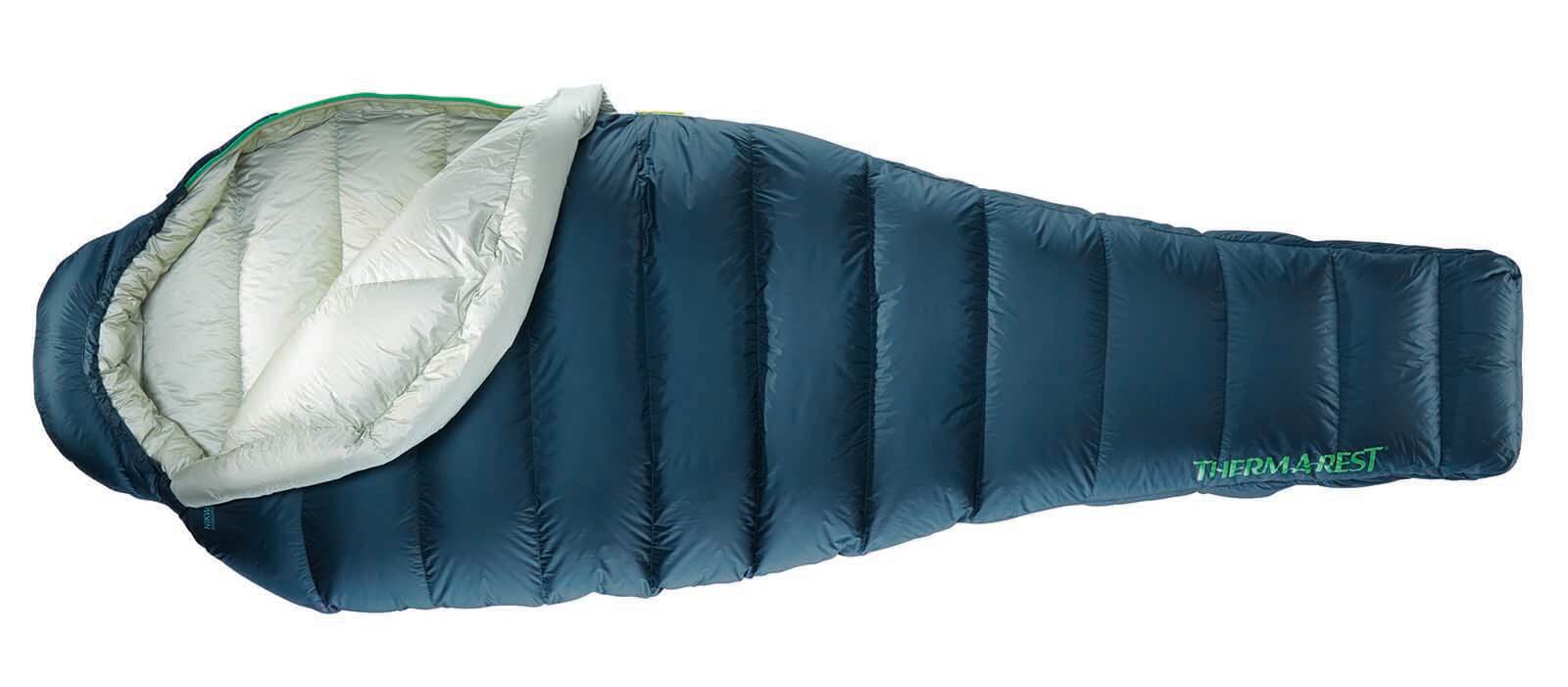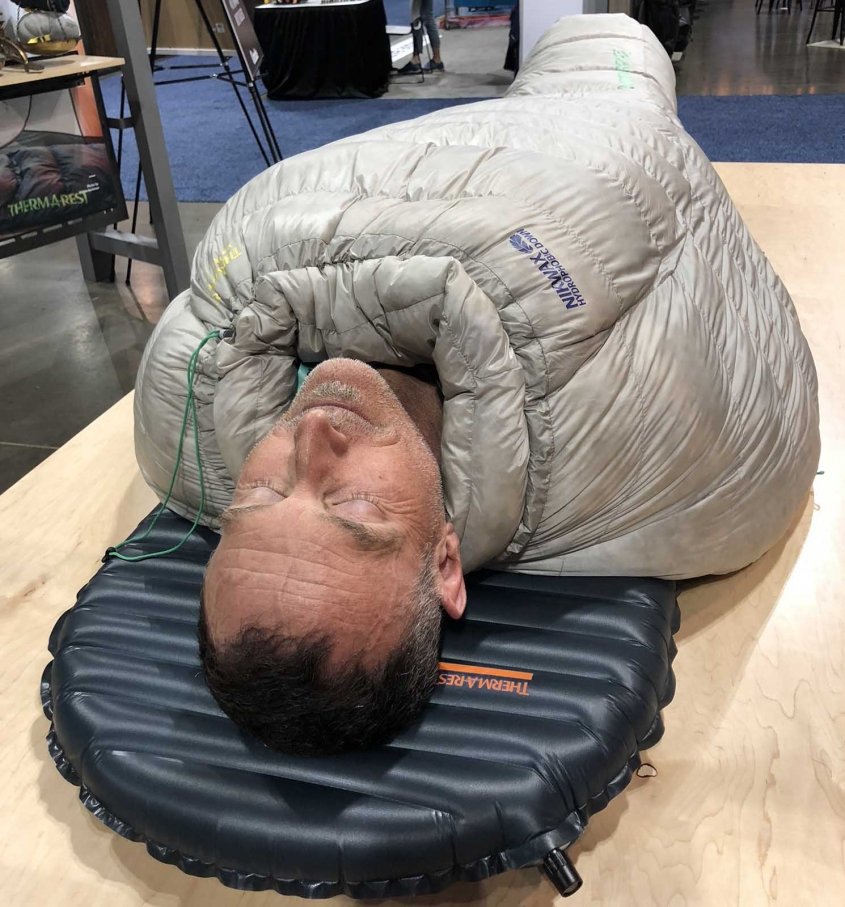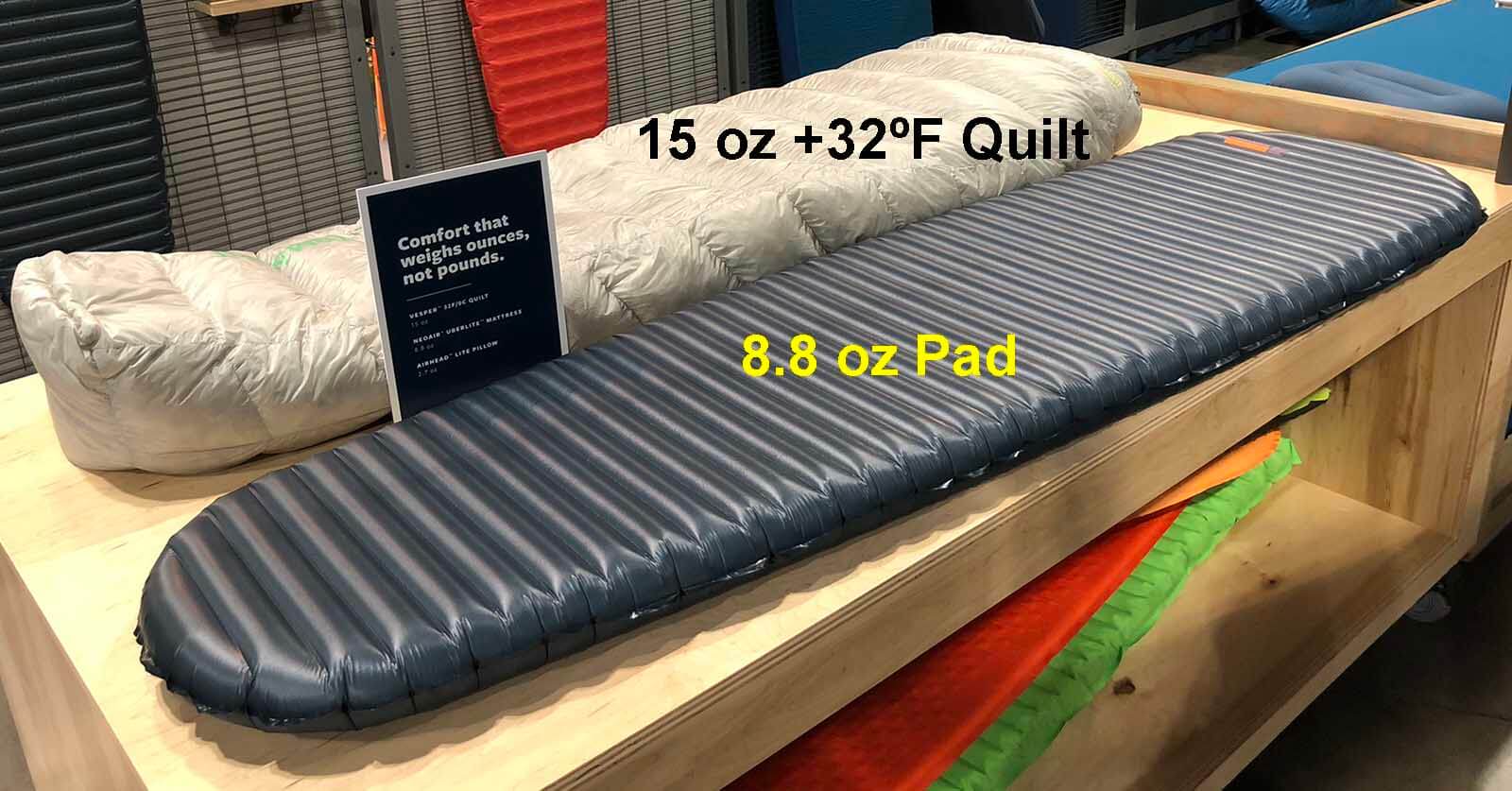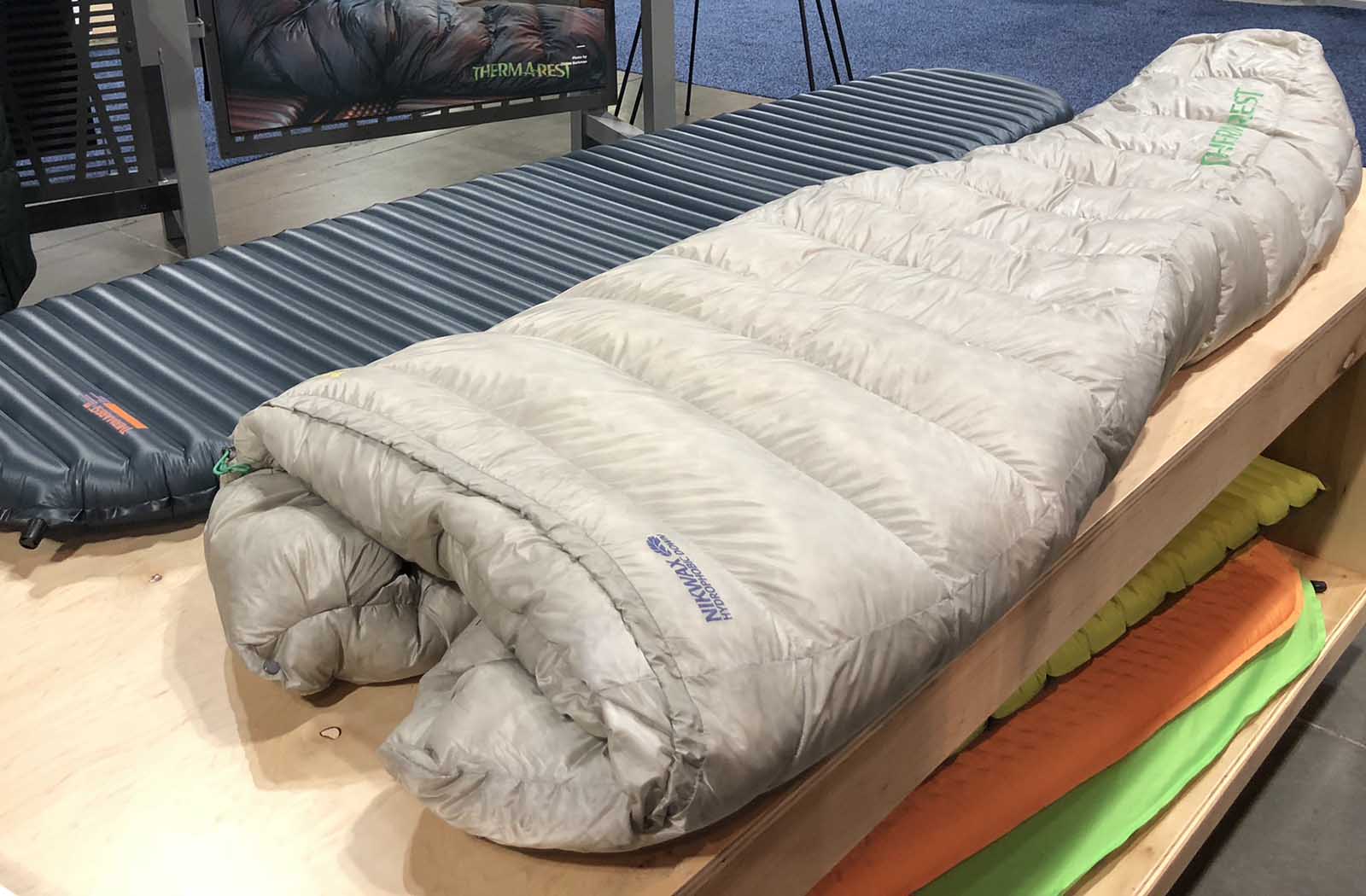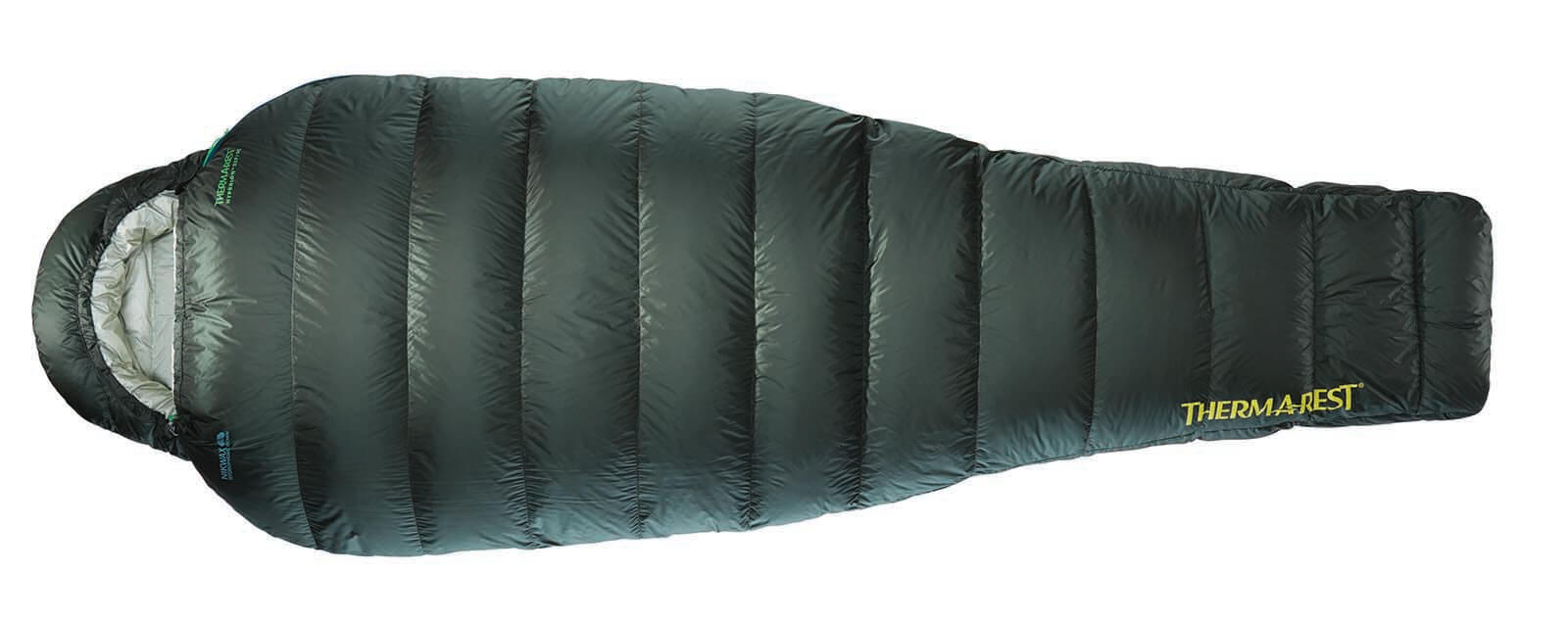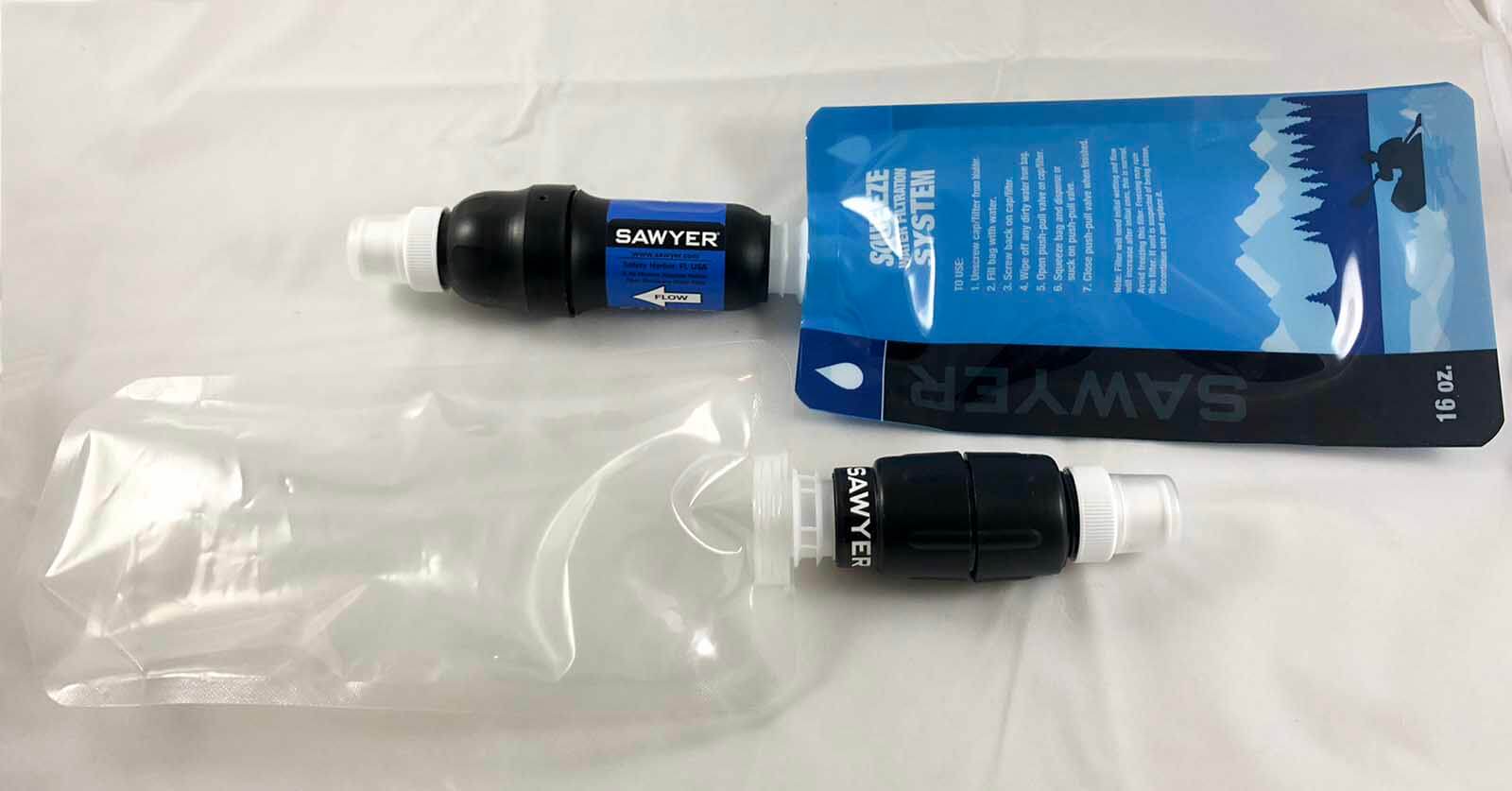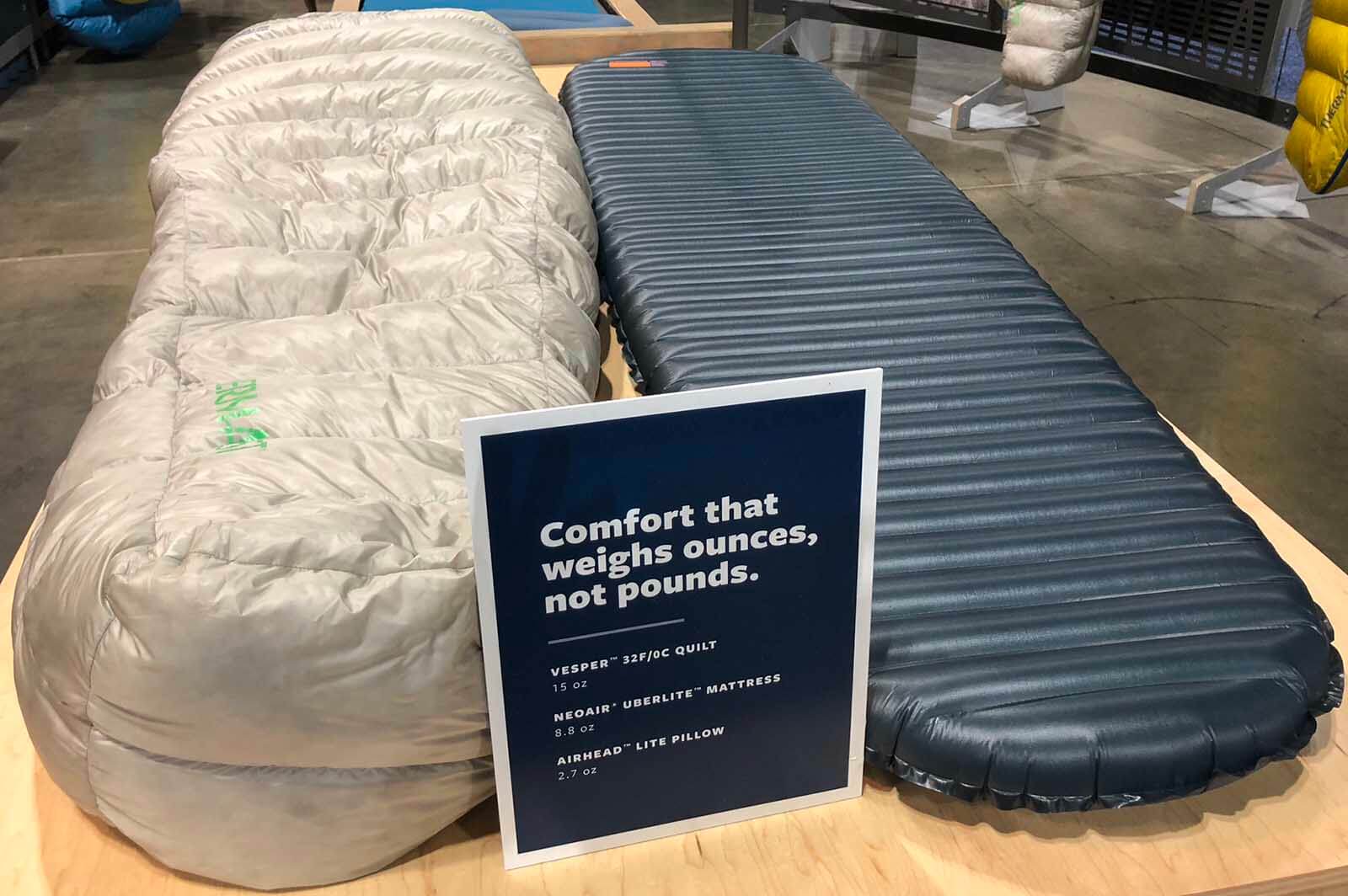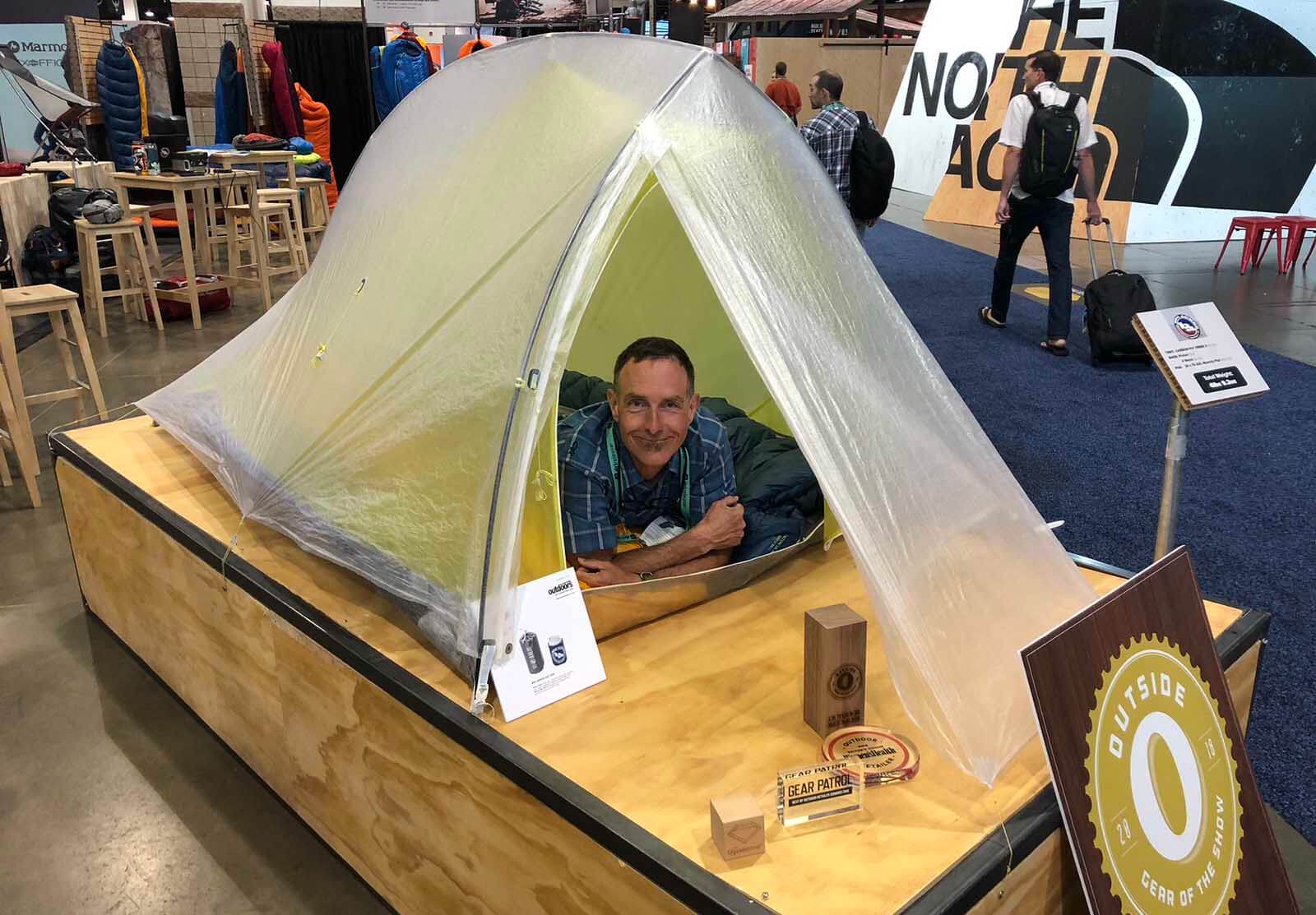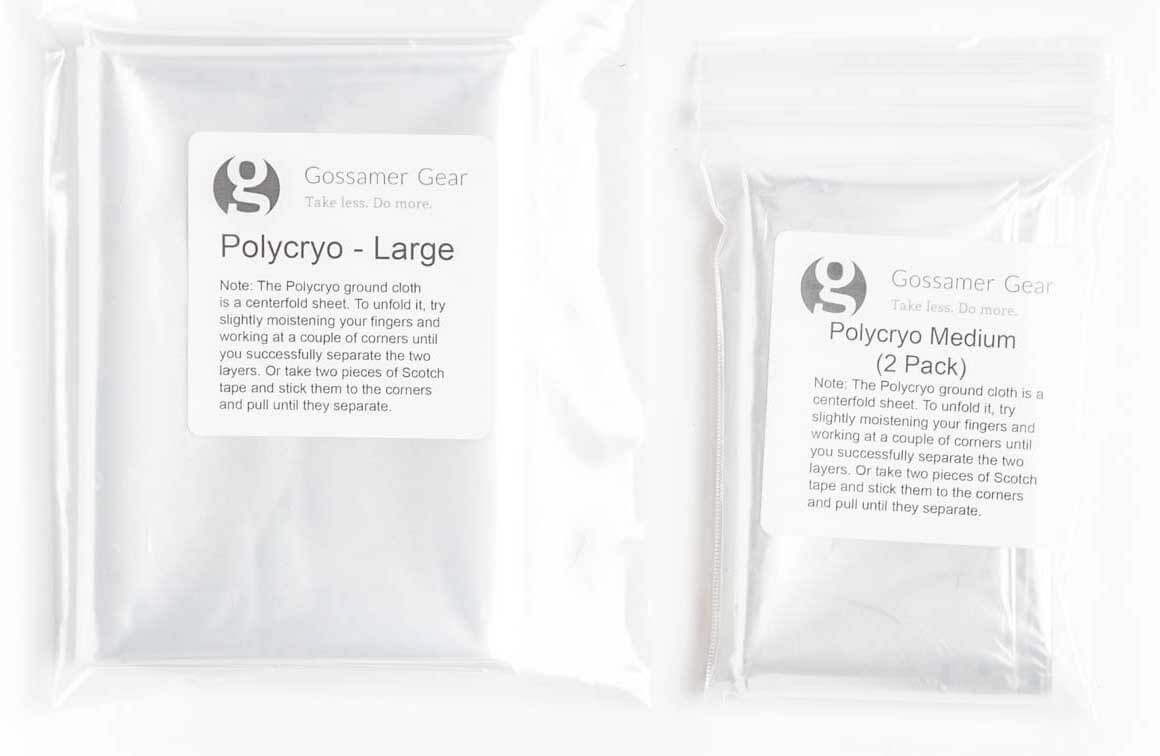The $16 HIKPRO 20L Backpack is a great value for a light daypack. Best, it delivers in-field performance at a fraction of the cost & weight of most daypacks from well-known brands.
For much of the US hammock tent camping is fantastic & arguably the best way to sleep in the backcountry. This is true anywhere with trees—nearly all of the eastern US & much of the Mountain West.
The Hammock Gear Wanderlust Complete Kit for Hammock Tent Camping raises the bar for an ultralight, low cost, easy to use, complete hammock kit. It has the some of the best thought out features and easy to use components/hardware we’ve seen…
At a scant 1.8 pounds the Hyperlite Mountain Gear Dirigo 2 Tent is a serious contender for the title of “strongest, lightest and most storm-worthy backpacking tent” on the market.
Kammok with their Mantis UL Hammock Tent, brings modern Hammock Tent camping into mainstream camping, backpacking and thru-hiking culture as viable option to traditional tent camping.
The 15 ounce! Cascade Designs Vesper Quilt debuted last month at the 2018 Outdoor Retailer show. When paired with the new ½ pound Therm-a-Rest NeoAir UberLite Mattress you get a +32 ºF sleep system that weighs a scant 1.5 pounds! That’s less than the individual weight of most sleeping bags or sleeping pads. In summary, with the Therm-a-Rest Vesper Quilt and Therm-a-Rest NeoAir UberLite Mattress you get it all — warmth, comfort AND incredibly low weight. As Therm-a-Rest says, “Comfort that weighs ounces not pounds” and “Better Sleep Guaranteed.” I am looking forward to field testing the Vesper Quilt to see if it meets these claims.
And New 16 oz +32 ºF Therm-a-Rest Hyperion Sleeping Bag!
In addition, Therm-a-Rest introduced two exciting ultralight sleeping bags: the Hyperion 32 Sleeping Bag rated a +32 ºF and just 16 oz in size regular!, and the Therm-a-Rest Hyperion 20 Sleeping Bag rated a +20 ºF and 1 lb 4 oz in size regular (more on this below). These two bags will be strong and exciting competitors to longtime ultralight sleeping bag favorites like the Western Mountaineering SummerLite, or the Marmot Phase 20/30 or Hydrogen and Atom Sleeping Bags.
Finally, an Ultralight Backpacking Quilt For the Masses? The Therm-a-Rest Vesper Quilt
Snug, warm and comfortable: You can see how the Therm-a-Rest Vesper Quilt snugs up around my neck and the side baffles (the obvious bulge on my right) around my sides to keep warm air in. Yes, I am a huge fan of quilts for backpacking. They are cheaper, lighter, and have a higher warmth-to-weight ratio than traditional sleeping bags.
What makes the Therm-a-Rest Vesper Quilt different is that its made by a major manufacturer and will likely be available on-the-shelf at major retailers like REI. Prior to this, for at least 10 years High Quality Ultralight Quilts have been available from a number of cottage manufacturers. These quilts were made to order and took about 4-8 weeks to deliver — an impediment to some prospective buyers. And even if you were OK with the delivery time, some backpackers were still uncomfortable ordering from cottage manufactures. Thus, the on-the-shelf available Therm-a-Rest Vesper Quilts may well open the gates to a new group backpackers to discover the joys and benefits of quilts.
| More reading: Learn about the many advantages of backpacking quilts and top picks like a $159 +20 ºF down quilt! in the 2018 Buyers Guide to Lightweight Backpacking Quilts. |
A 1.5 pound +32 sleeping system! The combined weight of the new Therm-a-Rest NeoAir UberLite Mattress and the with the new 15 ounce Vesper Quilt weighs less than most sleeping bag’s or pad’s individual weights.
What Stands out about the Therm-a-Rest Vesper Quilt (and Hyperion Bags)
What follows also applies for the most part to the new Hyperion Sleeping Bags
- An ultralight backpacking quilt (or sleeping bag) that will be available on-the-shelf from major retailers like REI.
- The highest quality 900 fill power Nikwax water resistant down. (Most high end bags and quilts are usually 800 or possibly 850 fill power at best.) And it’s Responsible Down Standard (RDS) certified.
- Therm-a-rest’s ThermaCapture* lining that prevents radiant heat escaping thus increasing warmth. This is also used in the Therm-a-Rest NeoAir Sleeping Pads.
- Side baffles (like wings) on the quilt that better seal around the edges in the critical torso area.
Note: Recently, there have been a few more semi-main-stream quilts available (altho none yet at REI). Most notably, the Western Mountaineering Nanolite +38 ºF Quilt, the Western Mountaineering Astralite +26 ºF Quilt and Feathered Friends line of Flicker Quilts.
Again, for the best of cottage manufacturer’s offerings including a +20 down quilt for only $159 see my 2018 Buyers Guide to Lightweight Backpacking Quilts.
Therm-a-Rest Vesper Quilt Specifications
Therm-a-Rest Vesper 32 Quilt – Regular: 15 oz, +32 ºF, $350 – Long: 1 lb 1 oz, $350
Therm-a-Rest Vesper 20 Quilt – Regular: 1 lb 3 oz, +20 ºF, $380 – Long: 1 lb 5 oz, $400
- Highest quality 900 fill power Nikwax water resistant down. Responsible Down Standard (RDS) certified.
- ThermaCapture lining that prevents radiant heat escaping thus increasing warmth
- Side baffles and a sewn/insulated foot box to increase warmth
- Very light 10 Denier Nylon DWR shell fabric
- SynergyLink connectors integrate the quilt with your mattress (that is they keep it in place over your pad and reduce drafts).
- Regular: L x W x Foot, 75 x 58 x 18 inches
- Long: L x W x Foot, 79 x 61 x 19 inches
Therm-a-Rest Hyperion Sleeping Bags Specifications
Therm-a-Rest Hyperion 32 Sleeping Bag – Small: 15oz, $349.95; Regular: 1lb, $369.95; Long: 1lb 2oz, $389.95
Therm-a-Rest Hyperion 20 Sleeping Bag – Small: 1lb 3oz, $399.95; Regular: 1lb 4oz, $419.95; Long: 1lb 6 oz, $439.95
- Highest quality 900 fill power Nikwax water resistant down. Responsible Down Standard (RDS) certified.
- ThermaCapture lining that prevents radiant heat escaping thus increasing warmth
- Very light 10 Denier Nylon DWR shell fabric
- Hyperion size regular fits 170cm – 183cm length (5ft 6in to 6ft) , Girth is 145cm (57in) at the shoulder, 126cm (50in) at the hip and 109cm (43in) at the foot.
*THERMACAPTURE™ (from Therm-a-Rest site)
ThermaCapture Radiant Heat Technology is a proprietary reflective coating that we apply to a range of surfaces. By reflecting radiant heat back to your body that is otherwise lost, this extremely lightweight coating turns that surface into a very efficient heat reflector, amplifying warmth without the excess weight or bulk of added, conventional insulating materials. According to Therm-a-Rest the “ThermaCapture lining treatment does not affect breathability. Breathability limited by the fabric.”
Disclaimer
This post contains affilate links. If you make a purchase after clicking on the these links, a portion of the sale helps support this site at no additional cost to you. I do not receive compensation from the companies whose products are listed. For product reviews: unless otherwise noted, products are purchased with my own funds. I am never under an obligation to write a review about any product. Finally, this post expresses my own independent opinion.
Sawyer introduced three items that should make the best water filter system on the market even better. The new mid-sized Sawyer Micro Squeeze Filter with the new squeeze pouch is 1/2 the weight of the full-sized Sawyer Squeeze filter with the old squeeze pouch. According to my scale (1.85 oz) the new Micro Squeeze Filter is even lighter than the 2.0 oz Sawyer Mini Filter.
And likely a game changer for Sawyer. They introduced a “Bottle Breather” that will make it easy peazy to drink from a filter mounted on a Smart Water bottle. Users of the ubiquitous Glaceau Smart Water bottle should be delighted!
Bottom of pic above: The new mid-sized Sawyer Micro Squeeze Filter with the new squeeze pouch. Top of pic: full-sized Sawyer Squeeze filter with the old squeeze pouch. The new system is 1/2 the weight for almost the same performance.
Quick Specs
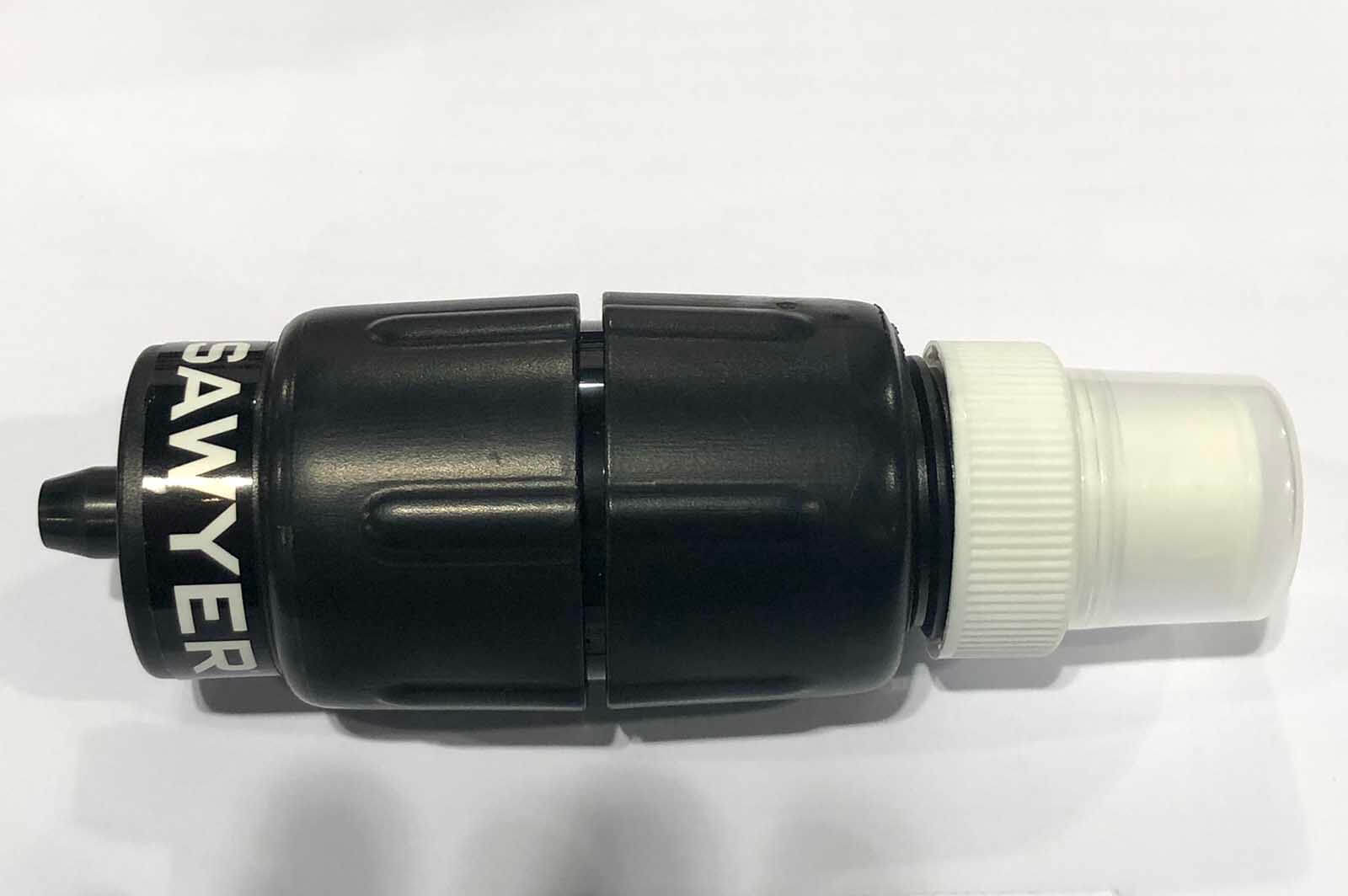
The new Sawyer Micro Squeeze Filter is 1/2 the weight of the larger, workhorse Squeeze Filter while retaining many of its more desirable features like a higher flow rate and less tendency to clog (vs. the Sawyer Mini Filter).
1. New Sawyer Micro Squeeze Filter 1.8 oz (52g) – This new filter hits the sweet spot between the very small Sawyer Mini Filter (lower flow rate & more prone to clogging) and the much larger, full-sized Squeeze (the Thru Hiker workhorse in the Sawyer line). Due to its larger diameter, the Micro Squeeze should have a higher flow rate than the Sawyer Mini Filter and be less prone to clogging. In addition, the new Micro Squeeze is far less cumbersome when attached to the end of a squeeze pouch or the ubiquitous Glaceau Smart Water bottle that many backpackers use.
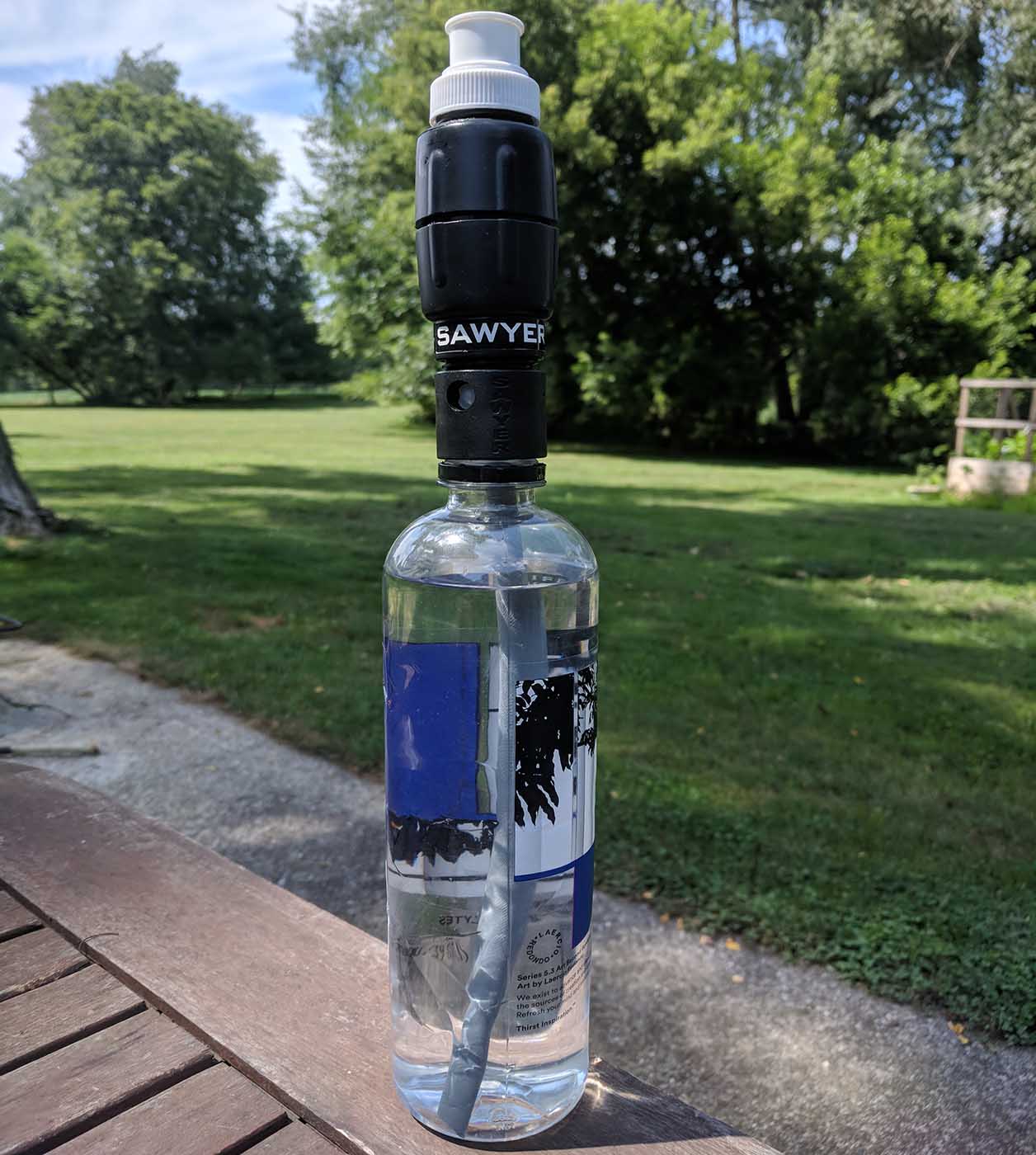
New Bottle Breather: A game changer for Sawyer and great news for Smart Bottle users! Shown in picture top to bottom – New Sawyer Micro Squeeze Filter, new Bottle Breather, and its cut-to-length tubing. All are mounted on the ubiquitous Glaceau Smart Water bottle.
2. New Bottle Breather 0.5 oz (less tubing) – This will be game changer for Sawyer and great news for Smart Bottle users! When you are drinking from a rigid water bottle (e.g. Glaceau Smart Water bottle) the new Sawyer Bottle Breather allows air to enter the bottle as you drink. This keeps the sides of the bottle from collapsing in and means that you don’t have to take your mouth off of the filter to “burp” more air into the bottle to continue drinking. The Bottle Breather comes with cut-to-length tubing (a straw). Note: this system works best when used with the bottle in a vertical position. [I expect to get a post-Outdoor Retailer Show test version of this soon.]
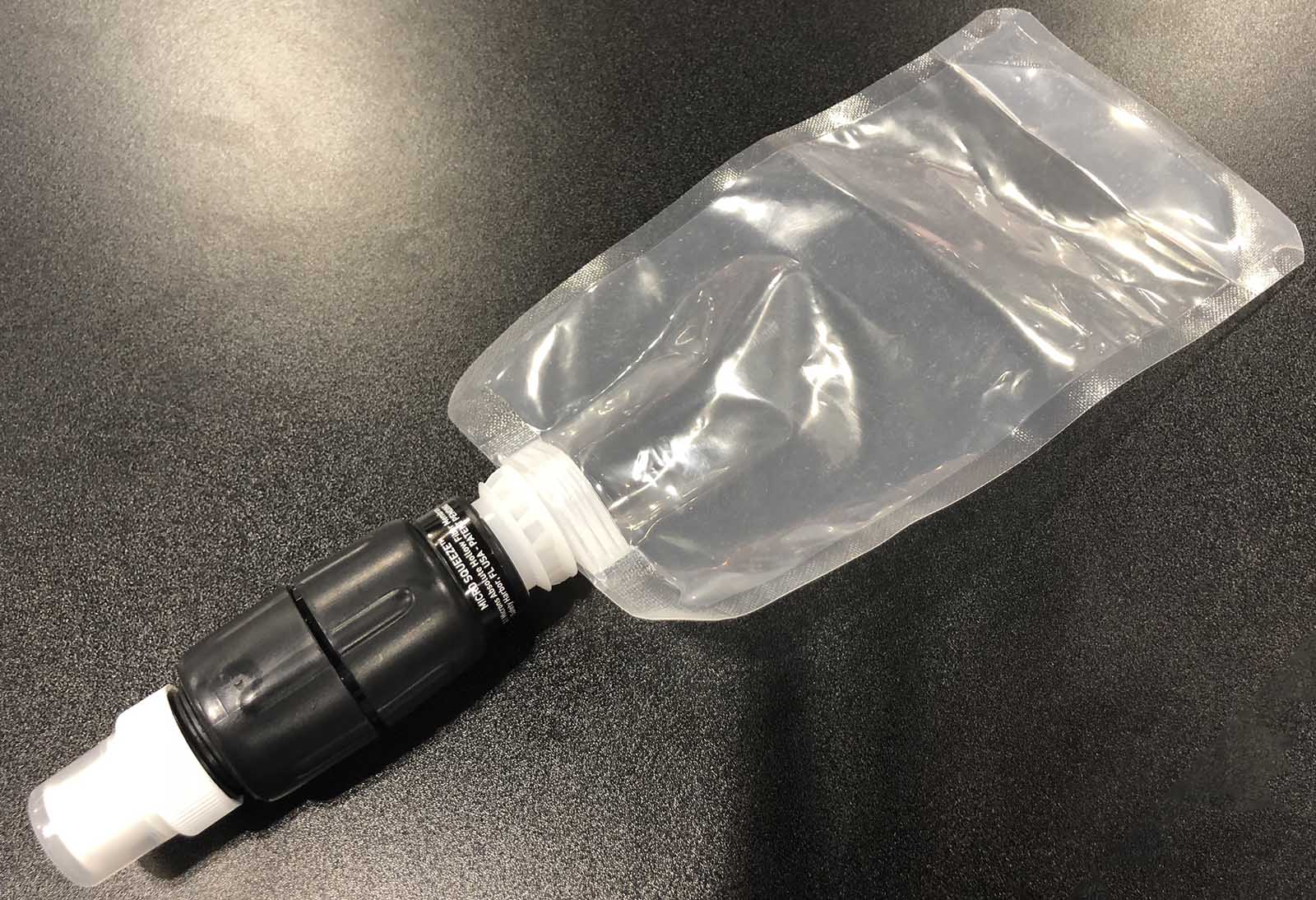
The new mid-sized Sawyer Micro Squeeze Filter with the new squeeze pouch is 1/2 the weight of the full-sized Sawyer Squeeze filter system.
3. New squeeze squeeze pouch 0.50 oz, 1 L size – Sawyer’s new squeeze pouch is 1/2 the weight of the old squeeze pouch, but just as strong. The pouch also has a new bottom gusset so the pouch fills easier and stands easier. The pouch uses a new proprietary polymer that Sawyer engineer John Smith declined to elaborate on. [Note: the pre-production pouch in this picture is clear. The new production pouches will be opaque (not clear), similar to current pouch design.]
Conclusion
I see the Micro with Bottle Breather as a game changer for fast, effective, hassle free water filtration for backpackers and hikers. This new system will easily fit in the side pocket of a backpack — quickly providing safe drinking water without the need for chemicals. In addition, a rigid water bottle is much easier to fill than the soft-sided squeeze pouches.
A lighter and lower cost alternate to the full-sized Squeeze Filter that has the full pop top bottle cap and higher flow rate (than Sawyer Mini Filter) will be appealing to hikers and backpackers that don’t beat the crap out of their gear for weeks or months on end. In addition, the new Micro Squeeze Filter is less bulky and cumbersome when mounted on the top of a Smart Water bottle or squeeze pouch.
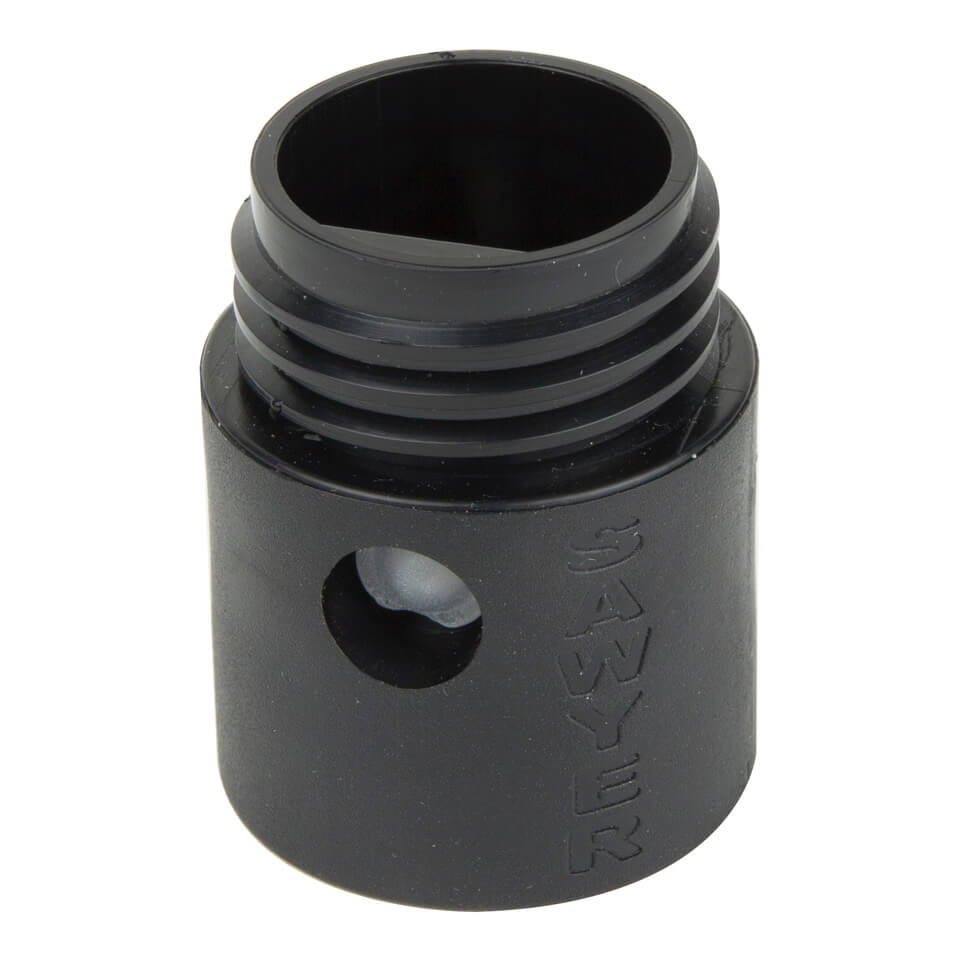
Close up detail shot of the new 0.5 oz Bottle Breather for Sawyer Micro Squeeze Filter
Disclaimer
This post contains affilate links. If you make a purchase after clicking on the these links, a portion of the sale helps support this site at no additional cost to you. I do not receive compensation from the companies whose products are listed. For product reviews: unless otherwise noted, products are purchased with my own funds. I am never under an obligation to write a review about any product. Finally, this post expresses my own independent opinion.
Air mattress comfort at foam pad weights! The new Therm-a-Rest NeoAir UberLite Mattress is the lightest insulated backpacking air mattress. To achieve the low weight, the Therm-a-Rest NeoAir UberLite Mattress uses an extremely light high tenacity nylon fabric for its shell. At the show, Jennifer Curto of T-rest assured me that mattresses with the new fabric had gone through extensive testing and had even survived being run over by a Jeep!
Specs Therm-a-Rest NeoAir UberLite Mattress
- 8.8 oz, R 2.0 Size Regular UberLite (72x20x2.5 inches) $180
- 6.0 oz, R 2.0 Size Small UberLite (47x20x2.5 inches) $140
- 12.0 oz, R 2.0 Size Large UberLite (77x25x2.5 inches) $210
- Availability Spring 2019
In comparison To
- 12.0 oz, R 3.2 Size Regular, Therm-a-Rest NeoAir XLite Sleeping Pad $170
- 12.0 oz, R 3.9 Size Regular, Therm-a-Rest NeoAir XLite Sleeping Pad – Women’s $160 (66x20x2.5 in & our current favorite mattress for both men and women — warm and comfortable!)
A 1.5 pound +32 sleeping system! The combined weight of the new Therm-a-Rest NeoAir UberLite Mattress and the with the new 15 ounce Vesper Quilt weighs less than most sleeping bag’s or pad’s individual weights. I will post more soon on the exciting new Vesper +32 and +20 ºF Quilts that were also announced at the 2018 Outdoor Retailer Show this month.
new UberLite vs. XLite – How it Works
With the 1/2 Pound Therm-a-Rest NeoAir UberLite Mattress, Therm-a-Rest dropped the weight of their lightest full-size air mattress by 25%. This was done with a lighter shell fabric, lighter internal baffling film, and by skipping radiant heat reflecting layers.
Warmth: To save weight the new UberLite eliminates the ThermaCapture* radiant heat reflecting layers used in XLite pads. This in part results in an insulating value of R 2.0 vs the R 3.2 for the standard XLite and R 3.9 for the Women’s which has an additional ThermaCapture radiant heat layer. Nonetheless an R 2.0 should be sufficient for most 3-season campers. For four season I would look to the R 3.9 Therm-a-Rest NeoAir XLite Sleeping Pad – Women’s (I’ve been down to +12 ºF with this pad) or for cold sleepers the R 5.7 Therm-a-Rest NeoAir XTherm Sleeping Pad.
Durability: According to Jennifer Curto, the new UberLite uses a 15 Denier High Tenacity Nylon Shell Fabric and the internal material [that creates the heat retaining baffles] is a super unique ultralight film. So the new shell fabric is 1/2 the weigh of the 30D fabric used in the XLite mattresses. Nonetheless, Curto says: “We cycle tested and field tested the NeoAir UberLite, even driving over it with a Jeep!.. We are confident that it meets Therm-a-Rest performance standards. That being said, the mattress deserves to be treated like any premium piece of ultralight gear.”
Conclusion
The success of the new Therm-a-Rest NeoAir UberLite Mattress will most likely hinge on the durability of the new 15 Denier High Tenacity Nylon Shell Fabric. Alison and I have had good luck with the durability of our 30D HT Nylon Therm-a-Rest NeoAir XLite Sleeping Pads since their introduction. We’ve had only one leaker, and that was a very slow leak that only required topping off once each the night to get us through the trip. Post trip, Therm-a-Rest warranteed us a new sleeping pad. While the 15D UberLite fabric is light, manufactures continue to find better and lighter materials and improved construction techniques with performance equaling or close to that of older heavier materials. I hope this is the case with the new Therm-a-Rest NeoAir UberLite Mattress. I am on the list to be one of the earlier testers, so stay tuned to learn more.
The other thing of note is the R 2.0 of the pad. This is almost 1/2 the insulation of our favored R 3.9 Therm-a-Rest NeoAir XLite Sleeping Pad – Women’s pads. This should be just fine for camping much of the year. But in shoulder seasons where I expect nighttime temperatures to routinely drop below freezing I would consider using the warmer/more insulating R 3.2 to R 3.9 XLite pads.
*THERMACAPTURE™ (from Therm-a-Rest site)
ThermaCapture Radiant Heat Technology is a proprietary reflective coating that we apply to a range of surfaces. By reflecting radiant heat back to your body that is otherwise lost, this extremely lightweight coating turns that surface into a very efficient heat reflector, amplifying warmth without the excess weight or bulk of added, conventional insulating materials.
Disclaimer
This post contains affilate links. If you make a purchase after clicking on the these links, a portion of the sale helps support this site at no additional cost to you. I do not receive compensation from the companies whose products are listed. For product reviews: unless otherwise noted, products are purchased with my own funds. I am never under an obligation to write a review about any product. Finally, this post expresses my own independent opinion.
The new Big Agnes Fly Creek HV 2 Carbon with Dyneema tent pictured above weighs just 1 lb 2 oz for a two-person, freestanding, double-walled tent with a full pole set! No trekking poles required. The incredibly popular, roomy and livable Tiger Walls series drops to 1.5 pounds with the new Big Agnes Tiger Wall 2 Carbon with Dyneema! And finally, the Big Agnes Scout 2 Carbon with Dyneema Tent is less than ¾ pounds. These are just a few of the new and very light tents that Big Agnes announced for Spring of ’19 at the Outdoor Retailer Summer Market trade show this month.
Be sure to checkout or Guide to:
- Best Backpacking Tent 2020 | Lightweight & Ultralight for a full selection of our top picks for the best tents for 2020, including some interesting Dyneema Tent options including some sub 1 pound Dyneema tents with a whopping 64 ft2 area about double the area of most 2-4 pound ultralight backpacking tents.
What you need to know about Big Agnes Tent Models – new Carbon With Dyneema vs. Platinum vs. Classic UL
Big Agnes now has 3 versions for most of their lightest tents. In order of heaviest to lightest they are the Classic UL, Platinum and the new Carbon With Dyneema version. This post clearly explains the major differences Big Agnes’ three lines of tents Classic UL vs. Platinum vs. Carbon With Dyneema as well as discussing the the pros, cons and cautions for each of three versions. This should help buyers make an informed choice. In summary:
- Classic UL uses 20d nylon fabric and aluminum poles. The least expensive and likely the most durable.
- Platinum uses much lighter and more delicate 7d fabric for the fly and floor and the same aluminum poles. This saves ~¼ pound for a 2-person tent and has a modest price increase.
- Carbon with Dyneema uses uber-tech Dyneema Composite Fabric (DCF) lighter carbon fiber poles. This saves ~½ pound or 30% for a 2-person tent but has a substantial price increase! [note: fly fabric is 0.34 oz/yd2 DCF and the floor is 0.51 oz/yd2 DCF]
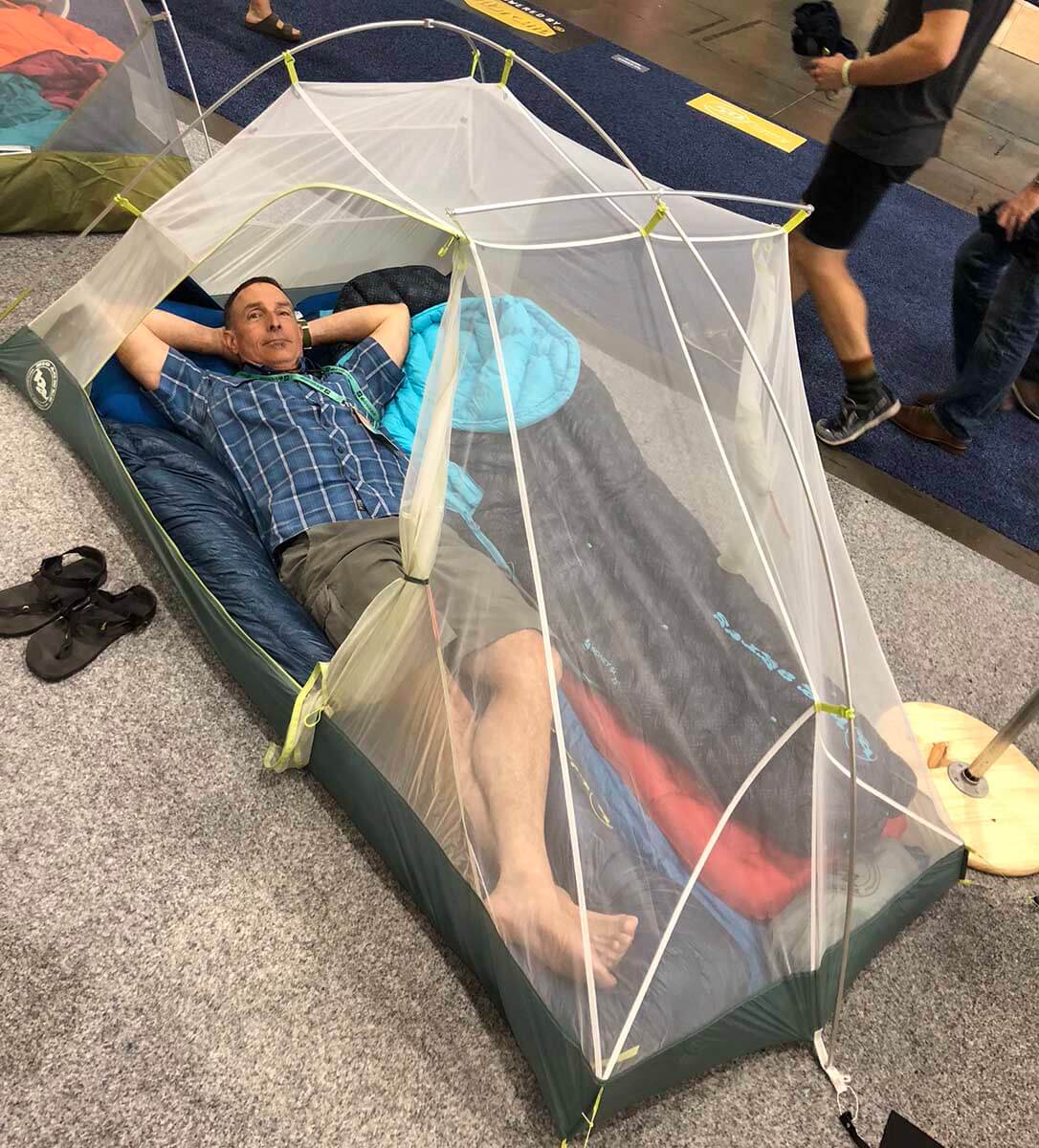
30% weight reduction: For Spring ’19 the highly popular, roomy and livable Tiger Wall UL2 tent will come in a Carbon with Dyneema version reducing its weight by 1/2 pound vs. the “classic” model show in the photo.
Big Agnes Tent – Carbon with Dyneema Version
Big Agnes, known for making some of the lightest backpacking tents, shaved even more weight from their lightest models. For spring of 2019 their “Carbon Collection” includes:
- 1 lb 14 oz (850g): Tiger Wall 2 Carbon with Dyneema Tent. That’s a 30% reduction in weight vs. the “classic” Tiger Wall Tent. My guess is that this tent will be the big seller in this lineup for its more spacious interior and a door for each person.
- 1 lb 2 oz (501g): Fly Creek HV 2 Carbon with Dyneema (lead photo for this post). This is an astonishing weight for a 2-person, double-walled, free-standing tent that does not rely on trekking poles! (Note that this shelter is snugger than the Tiger Wall and has a single door).
- 11 oz (312g): Scout 2 Carbon with Dyneema. That’s under a pound for a 2-person shelter with 27 ft2 of floor area! (Albeit it requires use of trekking poles, and it is a single door, single walled shelter that is more prone to condensation than the double walled versions above.)
The obvious omission in the Carbon Collection lineup are the Big Agnes Copper Spur HV UL series tents, the former mainstay of Big Agnes’ Ultralight tents. This is almost certainly due to the immense popularity of the new Big Agnes Tiger Wall tents.
Note: Durability these lighter tents, Platinum and Carbon with Dyneema Tents may hinge on a suitable footprint / groundsheet. Read more on this important topic below, including an extremely light $9 footprint hack.
The Three Big Agnes Tent Models Exlpained
In summary, Big Agnes now has 3 levels of weight and price for the same tent. These are from heaviest to lightest: Classic UL, Platinum and new for Spring ‘16 Carbon with Dyneema. The major reasons for lower weight and higher cost are included below using the Tiger Wall 2-person tent as an example:
- 2 lb 3 oz (992g) $400 for Classic UL version, theTiger Wall UL2 which uses 20d nylon fabric and aluminum poles
- 1 lb 15 oz (878g) $550 for the new Platinum version that uses a much lighter 7d for the fly and floor and aluminum poles
- 1 lb 9 oz (709g) $1,000 for the Carbon with Dyneema version that uses uber-tech Dyneema Composite Fabric (DCF) lighter carbon fiber poles. [fly fabric is 0.34 oz/yd2 DCF and the floor is 0.51 oz/yd2 DCF]
For 2019 the Fly Creek HV, Tiger Wall and Scout tents will be available in both Platinum and Carbon with Dyneema versions. In addition, the Copper Spur tents will be available in Platinum but not in Carbon with Dyneema.
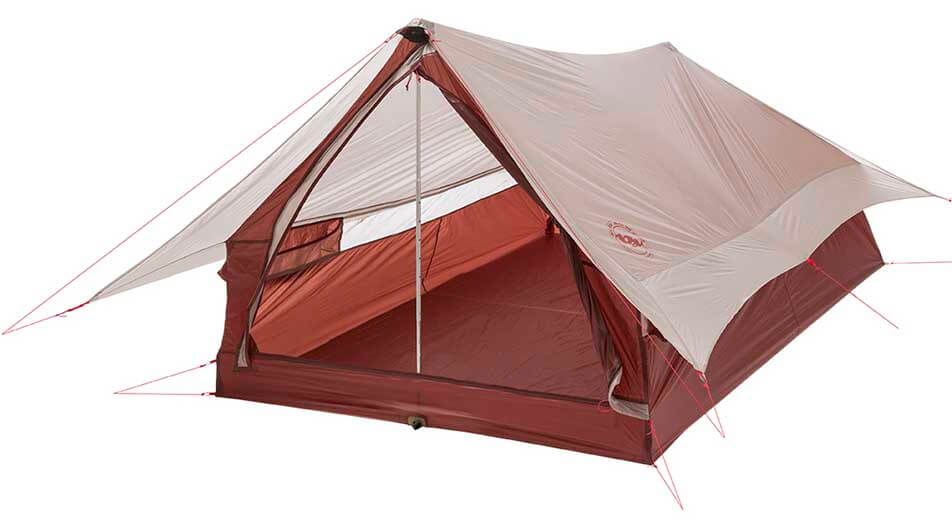
For 2109 the Big Agnes Scout 2 Carbon with Dyneema tent will come in at a scant 11 oz (312g). That’s under a well under pound for a 2-person shelter with 27 ft2 of floor area! [the tent pictured is the older silnylon model.]
Classic UL vs. Platinum vs. Carbon With Dyneema – Pros, Cons and Cautions
Classic UL – These tents are already among the lightest conventional, double-walled free-standing tents on the markets. While the lowest cost of the three lines they are still among some of pricier tents on the market due to their light weight. The 20d fabric used for the rainfly and wall/floor of the tent is likely the lightest fabric that will survive use by casual users (e.g. those people not experienced in the use and care of ultralight camping gear.) This fabric will likely remain waterproof and undamaged for a number of seasons of use, especially if you use a Big Agnes Footprint or a $9 Gossamer Gear Polycro Footprint under it.
Platinum – These tents use a much lighter 7d fabric used for the rainfly and wall/floor. This saves about 4 oz (¼ pound) and increases the price a few hundred dollars. And unless you are sleeping on nice soft grass, it almost requires you use a Big Agnes Footprint or a $9 Gossamer Gear Polycro Footprint under it. In addition, the lighter fabric requires that you use more care operating zippers, pitching and un-pitching the tent, etc to keep from damaging the fabric.
Carbon with Dyneema – These tents use uber-tech Dyneema Composite Fabric (DCF) for the rainfly and wall/floor and carbon fiber (vs. aluminum) poles to save ~1/2 lb or 30% vs a UL Classic Tent. DCF incredibly strong and waterproof and light. In addition, it’s stiff and has very low stretch when wet making it ideal for use in shelters. That is, DCF does not sag when wet fabric and you don’t need to re-tension the the tent in the rain. Downsides for DCF is that it is insane expensive and has only OK abrasion and puncture resistance.
In summary, the Carbon with Dyneema has clear advantages over the Classic UL version for its lighter weight and stiffer lower stretch fabric. It will be up to individuals to determine if those advantages are worth the significant increase in price. The advantages of the Platinum version vs. the Classic UL version are less clear.
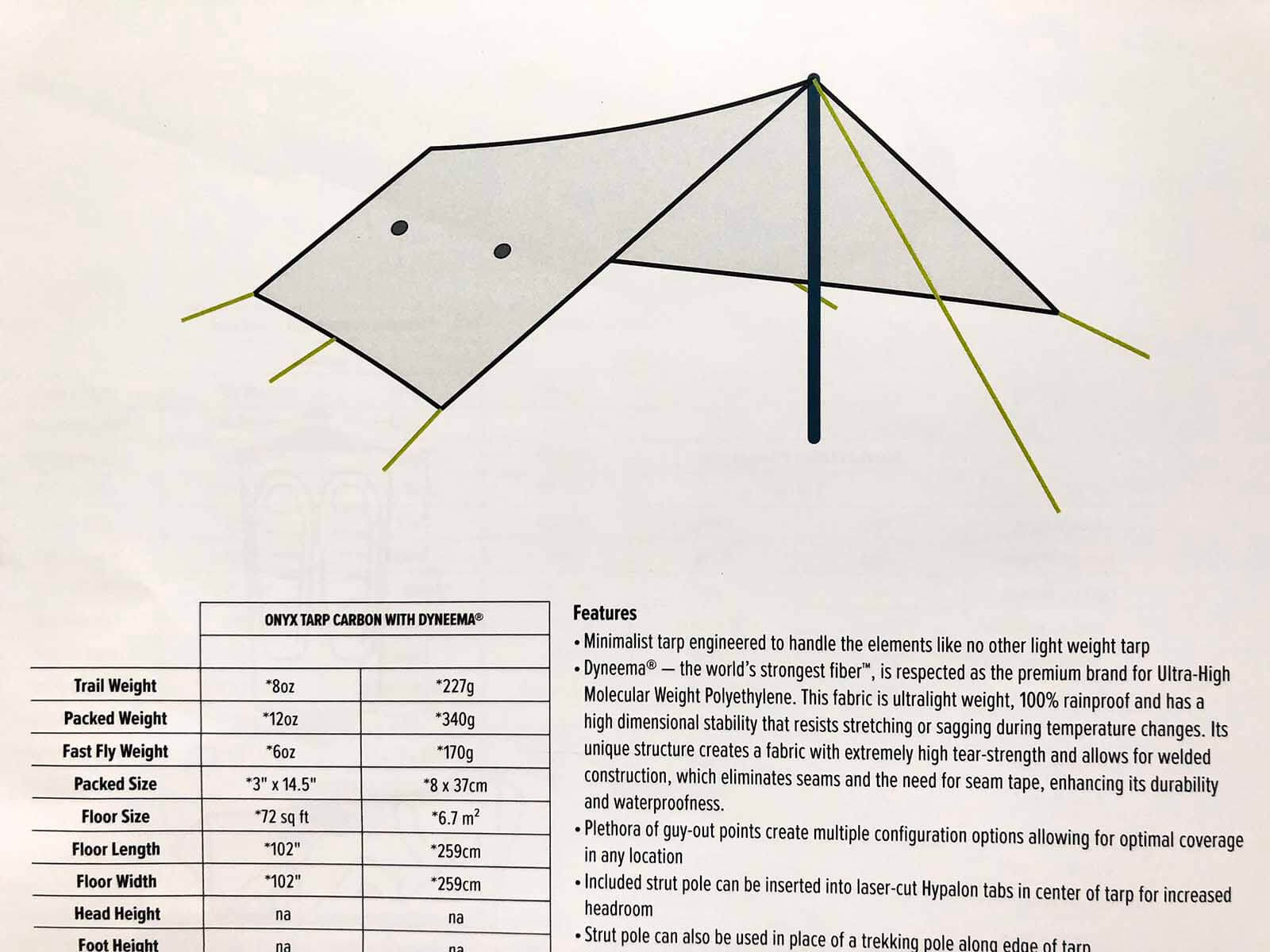
The Onyx Tarp Carbon with Dyneema is only 6 oz (170g) when used with trekking poles and covers 72 square feet. That’s super roomy for two people!
Durability of Big Agnes Carbon with Dyneema and Platinum Tents may hinge on a suitable footprint
Success of these tents may well rely on what BA puts under the floor to protect the more delicate DCF fabric tent floor. As of this writing BA has not revealed the weight and type of footprints that will be available for Carbon Collection tents. A too heavy footprint could negate much of the weight savings (right now a Big Agnes Tiger Wall UL2 Footprint weighs 6 oz and cost $70). On the other hand, not using a footprint could quickly damage your floor if you are not careful and/or experienced at campsite selection.
Use an off-the-shelf Polycro Footprint
The good news is you don’t need to wait for BA to solve this problem. To protect the floor of these very light tents, I would recommend putting a $9 Gossamer Gear Polycro Footprint under it. This multilayer, cross-linked polyolefin film weighs less than 4 oz and is much stronger and more durable than the typical painters plastic sheet you’d get at a hardware store. It’s also ~ 1/2 the weight and 12% the cost of a Big Agnes footprint. It should last for weeks of use. When it starts to wear it can easily be replaced by another $9 footprint.
Durability Verdict Not in for Big Agnes Carbon with Dyneema and Platinum Tents
Finally, neither the Big Agnes Platinum Tents (only a few models out last year), and the Big Agnes Carbon with Dyneema Tents (not due until Spring ’19) have had sufficient field testing to determine their long term durability and waterproofness. It will be interesting to hear the feedback from consummate backpackers & thru-hikers that use these shelters for weeks or months on end vs. the casual weekend backpacker.
DCF has been used for years by cottage manufactures for Tarps and Pyramid shelters, and even floors on Bivy Sacks. I own and love many of these shelters. They have been all over the world with me from Patagonia to Alaska. But none of these simple DCF shelters are tents with their complex of poles and multitude of panels and seams. By making complex tents with DCF, BA is entering uncharted territory. To give BA the benefit of the doubt, they have been one of the most successful manufactures of very light tents. As such, I wish them continued success with their new Carbon with Dyneema tents. I look forward to testing the Tiger Wall 2 Carbon with Dyneema as soon as it is available.
Disclaimer
This post contains affilate links. If you make a purchase after clicking on the these links, a portion of the sale helps support this site at no additional cost to you. I do not receive compensation from the companies whose products are listed. For product reviews: unless otherwise noted, products are purchased with my own funds. I am never under an obligation to write a review about any product. Finally, this post expresses my own independent opinion.
The Sony a7R III and a7R II are the perfect pro cameras for hiking and ultralight backpacking. They give you pro quality photos but without the weight. That is, this Sony camera gear is capable of the highest image quality but still light enough to be easily carried into the backcountry for a long day hike or a multi-day backpacking trip.
Lead photo above: Author working in Iceland with light Pro camera gear. Sony α7R II camera with Sony FE Carl Zeiss T* 24-70mm F4 ZA OSS lens on a Sirui T-024X Traveler Light Carbon Fiber Tripod. [Photo credit – Peyton Hale]
Why Take a Pro Camera Hiking?
If you want the maximum image quality but the least weight, your best option is a light full frame (FF), mirrorless camera like the Sony A7R II or A7R III. The following summarizes the ways a full frame camera is better than crop format (CF) camera like the Sony α6000 or α6500.
- A full frame (FF) camera like the Sony A7R II or A7R III can have up to 4x more resolution than a crop format (CF) camera like the Sony a6x000 series (37 pMP vs 8 pMp)
- A FF camera is more weight efficient for resolution. That is, you get more resolution (megapixels) per ounce than a CF camera.
- A FF camera also has more dynamic range (ability to capture a large range of lights and darks), color depth, and better low light performance.
Looking at the chart above you can see that 1) a full frame camera is capable of 4 times the resolution of a crop format camera, 37 pMP1 vs 8 pMP1 (left chart column cluster), and 2) that a full frame camera is more weight efficient, giving you almost 2x more megapixels of resolution per ounce of camera weight (right chart column cluster). 1 See more about pMP (perceptual megapixels)
What is a Full Frame Camera and How is it “Better”
Larger Full Frame sensor = better image quality: A full frame camera has a sensor* twice the size of a crop format camera (APS-C). And a larger sensor means better image quality. That is, the larger the sensor of a full frame camera gives more resolution (megapixels). But possibly more important, the larger sensor of a full frame cameras captures more light. And more light translates to better dynamic range (ability to capture a large range of lights and darks, many times critical for landscape photos), more color depth, and better low light performance/high ISO (also critical for photos in the “golden light” of dawn and dusk).
Better Lenses: Not a hard and fast rule, but the “better” lenses for full frame cameras tend to be superior to the best lenses for crop format cameras (but admittedly heavier and more expensive). E.g. the best Sony full frame wide angle zoom can resolve up to 35 pMP (on the 42 MP Sony α7R II) vs. the best Sony wide angle crop format zoom can resolve only 8 pMP (on the 24 MP Sony α6000). Taking into account sensor sizes, the full frame lens resolves 83% of the full frame sensor but the crop format lens only resolves 33% of its sensor’s capability.
- 860 mm² sensor area Full-Frame digital camera format, (36×24 mm)
- 370 mm² sensor area APS-C (crop format) standard format from Nikon, Sony… (23.6×15.7 mm)
* The sensor is the electronic hardware in a camera that captures light from the lens and converts it to an image/photo. Read more here.
A Caution – It’s not all about Megapixels
Just to put things in perspective: Getting good focus, correct exposure, eliminating camera shake (and of course, being in the right place at the right time!) are all more important than the megapixels of your camera. That is, you need to nail all of these to get the most of out a high-end camera. Blow any one of them and the resulting photo will likely be worse than one properly taken on a far less expensive camera or even a smartphone. [See more on how to get the best photos from your smartphone.]
Recommended – Light Pro Cameras for Hiking and Ultralight Backpacking
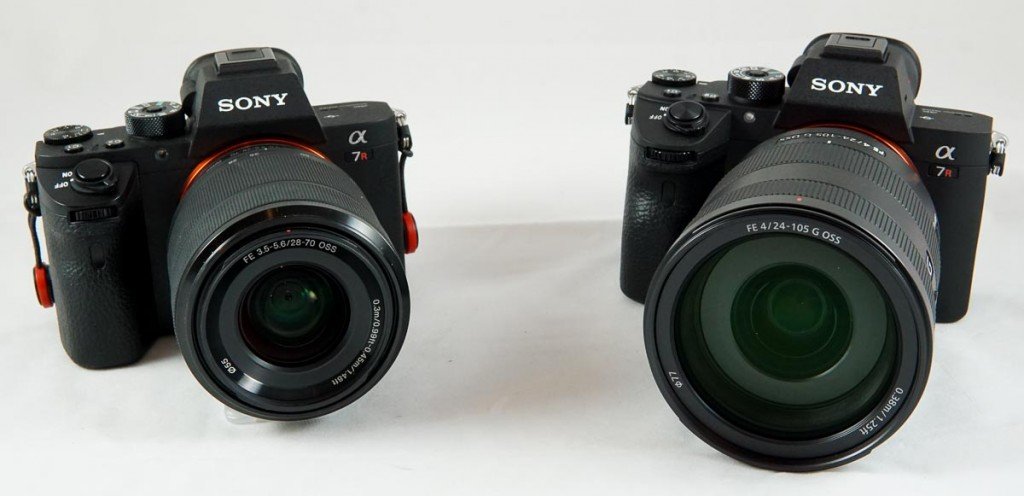
On the left is the Sony α7R II with the “general purpose” Sony 28-70mm F3.5-5.6 FE OSS Lens. It’s a light, economical, high resolution camera appropriate for almost all situations encountered hiking and backpacking. And it’s $1,800 and 13 oz less than the Sony α7R III with a FE 24-105mm f/4 G OSS Lens on the right. That being said, the α7R III with 24-105 has a significant advantage in image quality.
Standard Camera (on left above)
Sony α7R II 22.0 oz (625 g): This is the best value in a high quality FF mirrorless camera. It has the same 42 MP resolution as the newer and more expensive Sony α7R III. The Sony α7R II has nearly 14 stops of dynamic range (ability to capture a large range of light to dark without losing detail) and excellent autofocusing. When paired with the “general purpose” Sony 28-70mm F3.5-5.6 FE OSS Lens you have a light, economical, high resolution camera appropriate for almost all situations encountered hiking and backpacking. And it’s $1,800 and 13 oz less than the Sony α7R III with a FE 24-105mm f/4 G OSS Lens.
The Upgrade Camera (on right above)
Sony α7R III – 23.2oz (657g): This is the best light FF camera on the market! It outperforms the best from Nikon and Canon but weighs ¾ of a pound less! The Nikon D850 is 35.5oz (1005g) and the Canon EOS 5DS R is 35.6oz (1010g).
This camera has the same 42 MP resolution as its predecessor the α7R II, but improves upon it in many ways. Key features for hikers and backpackers are: 1) With 15 stops of dynamic range it bests the the α7R II by a full stop. 2) Battery life has doubled with the new Sony NP-FZ100 2280mAh battery. 3) Autofocus is more sophisticated, faster and more accurate. 4) Its 5-axis in-body image stabilization claims a full 5.5 stops.
Pair the Sony α7R III with the insanely sharp Sony FE 16-35mm f/2.8 GM Lens and you have a light, backcountry camera with image quality second to none. An added bonus, it’s so sharp that at 16mm and f/2.8, it can double as a good astro lens (making its weight and cost seem more reasonable). Or pair it with the new and moderately priced Sony FE 24-105mm f/4 G OSS, possibly the best midrange zoom lens in on the market
Note: All Sony gear was purchased with my own funds and this post reflects my own personal opinions. I am not a “Sony ambassador,” nor obligated to write content, or receive compensation from Sony.
Decide if Full Frame Image Quaintly Makes Sense for You
The increased image quality of Full frame is not cheap. That is, a full frame camera costs and weighs more than a crop format camera. Each hiker will need to decide if a potential 4x increase in megapixels (and other benefits like increased dynamic range, color depth, & low light performance) are worth it:
|
Recommended Lenses
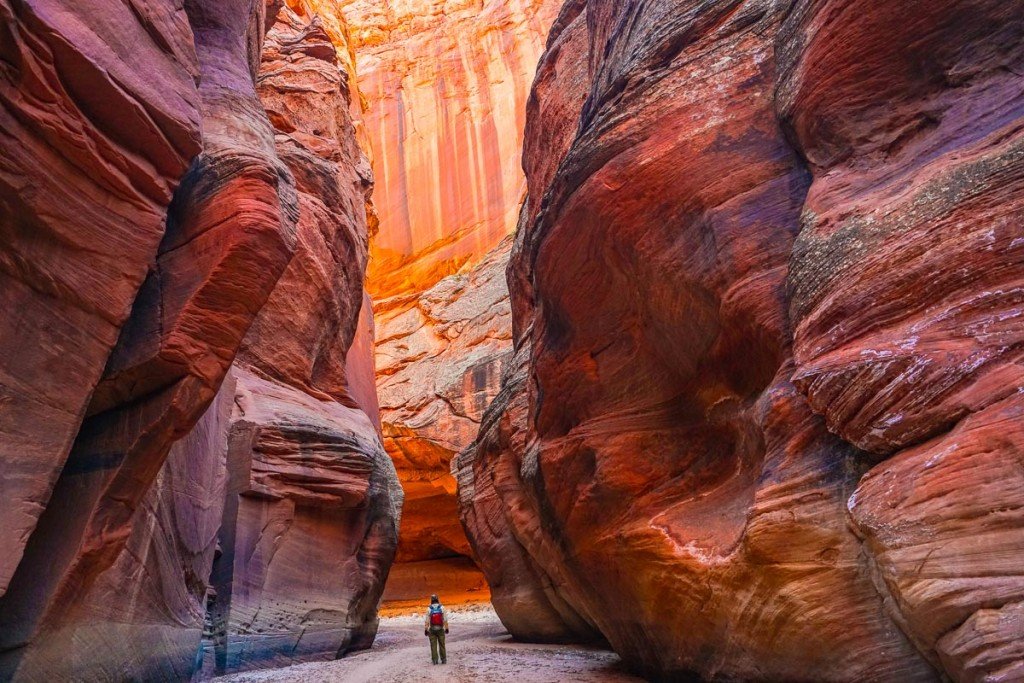
Buckskin Gulch Utah: Hand held with a Sony α7R II with Sony Vario-Tessar T* FE 16-35mm f/4 ZA OSS lens.
The following lenses were carefully selected to provide an optimal balance of sharpness, low weight, and reasonable cost (for a full frame lens). An effort was made to provide a few price and weight options for each lens type.
General Purpose (midrange) Zoom Lenses
If you are bringing only one lens, a General Purpose (midrange) Zoom is likely the one you want. These are workhorse lenses going from a decent wide angle to a moderate zoom. They come in two flavors, ~24mm-70mm and ~24-105mm. The 24-70s are lighter and more compact. But the 24-105 range is especially useful. 24mm is plenty wide enough for most landscape work. And 105mm is good for picking out landscape details. And in a pinch, at 105mm it works as a wildlife zoom since with 42 MP you can crop down to the sharp center area of the lens and still have a serviceable photo. (another advantage of FF)
Bargain Lens
♦Sony 28-70mm F3.5-5.6 FE OSS Lens 10.4 oz: This “starter” lens for the Sony FF (FE) cameras is a great value and a perfect fit for hikers and ultralight backpackers. It far exceeds expectations, and the international version can be had for $285! This lens is very light and nearly as sharp as the next lens “up,” the far more expensive and heavier 24-70mm F4 ZA OSS. The 28-70 F3.5-5.6 is weather resistant while the 24-70mm F4 is not. The 28-70 gives up some edge sharpness at wider apertures vs. the 24-70mm F4. And its narrower 28mm vs. 24mm makes more of a difference for landscape work than the “slight” 4mm difference might infer. Nonetheless, you are unlikely to find a better low cost full frame lens suited to rugged backcountry use*.
*Its light weight and low cost make this a great lens to take into harsh environments with higher risk of damage, theft, etc. The lens is the most likely thing to be damaged. And if that happens, you are only out a few hundred vs. a few thousand dollars. E.g. this is the lens I took to remote mountain regions in Cuba, and the one I would take for a long trip to the desert with all its fine windblown sand.
Upgrade Lenses
♦Sony FE 24-105mm f/4 G OSS 23.4 oz: This new and exciting lens is likely the the best midrange zoom lens on the market. It’s only been out for a few months but my initial impressions (and those of many others) is that it’s extremely sharp edge to edge–coming close to the performance of far more expensive lenses. It’s about 1/2 the price of most of the competition but it’s smaller, lighter, image stabilized and weather resistant. In summary, a great pro-quality lens at a bargain price [In fact, it takes much of the market away from the heavier and more costly Sony 24-70 f/2.8 and Sony 24-70 f/4].
Sony FE Carl Zeiss Vario-Tessar T* 24-70mm F4 ZA OSS 15 oz: Prior to the 24-105mm f/4 G OSS, this would have been the light general purpose zoom of choice. It is sharper edge to edge vs. the less expensive 28-70mm F3.5-5.6 OSS. And even now, if you need a lens in this focal range for under 16 oz, choose this one (the 24-105mm f/4 G OSS is a full 10 oz heavier).
Wide Angle Zooms
A wide angle zoom in the range of 16mm-35mm is on my camera most of the time (I use this focal range for over 2/3 of my backcountry photos). The 16 to 24 mm range is especially useful for capturing broad swaths of landscape or creating stunning perspectives that give snap to your photos.
Standard Lens (no budget lenses here)
Sony Vario-Tessar T* FE 16-35mm f/4 ZA OSS 18.3 oz: If you need a small and light wide angle zoom this is it. The lens is sharper in the corners than the 28-70 f/3.5-5.6, image stabilized, and it doesn’t cost an arm and a leg. But it’s not as sharp as the new, non-image stabilized 16-35mm f/2.8 GM (below). Even so, I’ve carried this lens on many, many trips. And I will continue to take it when weight is critical.
Upgrade Lens
Sony FE 16-35mm f/2.8 GM Lens 24 oz: This Sony G-Master lens one of the best wide angle zooms on the market. It’s so sharp edge to edge that its sharper than most prime lenses in its focal range. It’s ¼ pound lighter than Canon’s 16-35 f/2.8 lens (and some, but not all, reviewers have tested it sharper than the Canon). And Nikon has nothing that can touch it. An added bonus, it’s sharp enough at 16mm and f/2.8 that it can double as a decent astro lens (and make its weight seem more reasonable). Its major downside is cost — but you get what you pay for.
Prime (fixed focal length) Lenses
These lenses are lighter and usually sharper than zoom lenses. Price varies over a wide range from inexpensive to quite expensive.
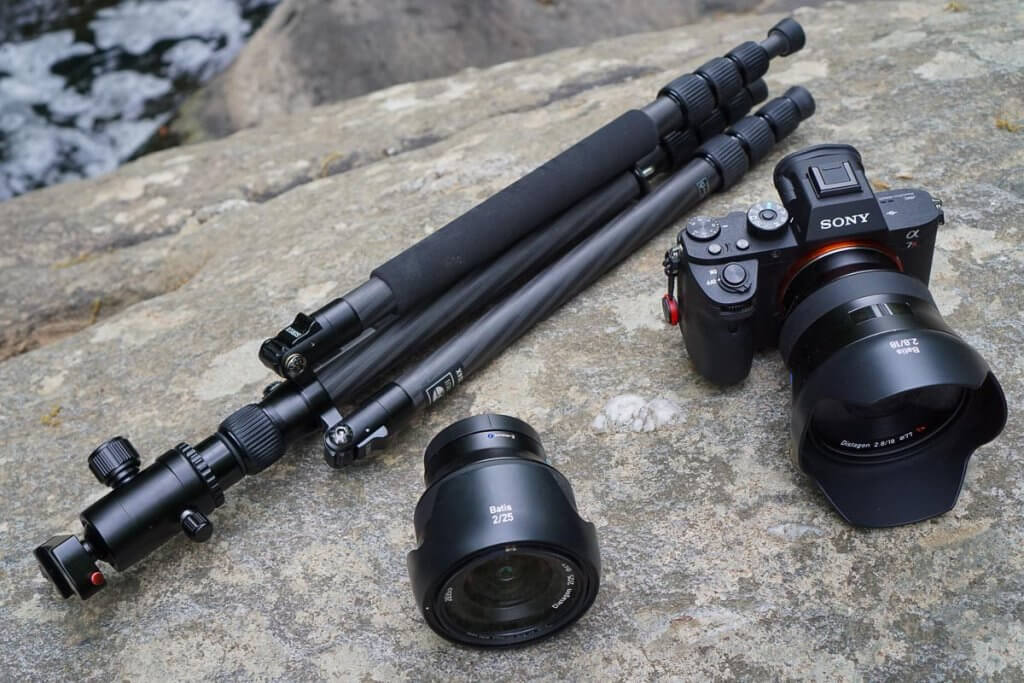
Two light, fast and exceptionally sharp prime lenses: (r) one of my favorite lenses the ZEISS Batis 18mm f/2.8 Sony FE, 11.64 oz; (l) Carl Zeiss Batis 25mm F2 Sony FE 11.82 oz. In the backgroud is the Sirui T-024X Traveler Light Carbon Fiber Tripod with C-10S Ball Head, a light, economical and capable backcountry tripod.
Normal Prime Lenses
♦ Sony FE 50mm F2.8 MACRO 8.3 (236 g): This is the VALUE winner in Sony’s FE lens lineup. Almost as sharp as 55mm f/1.8 below but 1/2 the cost, and 1.5 ounces lighter, and dust and moisture resistant. Oh, and it goes 1:1 for macro photography.
Sony Sonnar T* FE 55mm f/1.8 ZA 9.9 (281 g): The lightweight star of Sony’s FE lens lineup. The 55 f/1.8 FE is light, small and insane sharp (resolving to 40 pMP!). Perfect for shooting handheld in low light situations. Not really cheap, but likely still a bargain given its performance.
Wide Angle Prime Lenses
These are mostly listed in order of focal length. And I have tried to keep cost down (within reason) on most of these selections.
♦ Rokinon 14mm f/2.8 ED AS IF UMC Lens for Sony E-Mount 20.11 oz (570 g) – A great value for an excellent and sharp astro (and landscape lens). Downside is that it is fully manual. But then that’s desirable for astro photography and just fine when you are shooting landscapes off a tripod.
Laowa 12mm f/2.8 1.34 lb (609 g) – Amazingly wide and sharp. It has zero distortion which is nothing short of magic for a lens this wide. Great mechanical build. It also makes a decent astro lens. Downside is that everything is manual, so it’s not as handheld friendly as lenses that electronically couple with your camera. Oh, and it’s not light!
ZEISS Batis 18mm f/2.8 Sony FE 11.64 oz (330 g) – A personal favorite. Super sharp, light and compact. A standout landscape and astro lens. A “native” Sony FE lens, it couples electronically with the camera. Only downside is cost.
♦ Sony FE 28mm F2 – Inexpensive, fast, light and crazy sharp. A solid focal length for many landscape shots. And if you can live with 28mm, it makes a good astro lens. It’s also a fantastic deal. (not quite as sharp at f/2 as the more expensive competition)
Carl Zeiss Batis 25mm F2 Sony FE 11.82 oz (335 g) – A bread n’ butter landscape lens. Light and fast with outstanding sharpness edge to edge — even wide open. Only downside is cost.
♦ Sony FE Carl Zeiss Sonnar T* 35mm F2.8 ZA 4.2 oz 120 – Crazy light and small for a great utility wide angle lens. Moderate cost given its high performance and dust and moisture resistance.
Telephotos Lenses
I rarely use these on backpacking trips where carrying a bulky and heavy lens for days seems like a bad idea. Even light telephotos lenses are heavy, expensive and infrequently used (unless your goal is photographing wildlife or climbers, etc.). As mentioned earlier if I need a long lens on backcountry trip, I make due with cropping an image from the 24-105mm f/4 G OSS.
Tripods
My choice for a backcountry tripod is the light and low cost Sirui T-024X Traveler Light Carbon Fiber Tripod with C-10S Ball Head. In many (but not all) situations it will work for a Sony α7R II camera with a lighter lens like the Sony 28-70mm F3.5-5.6 FE OSS Lens or 16/35 f/4. It will hold the camera quite stable (using a remote shutter or 2 sec delay) given the wind is not too strong or tripod legs aren’t a few feet deep in rushing water. (And you can hang weight off the center column if you need more stability.) That being said, for heavier lenses like a 70-200 zoom or the 16-35 f/2.8, while the legs are fine, you’ll likely need to use a larger ball head.
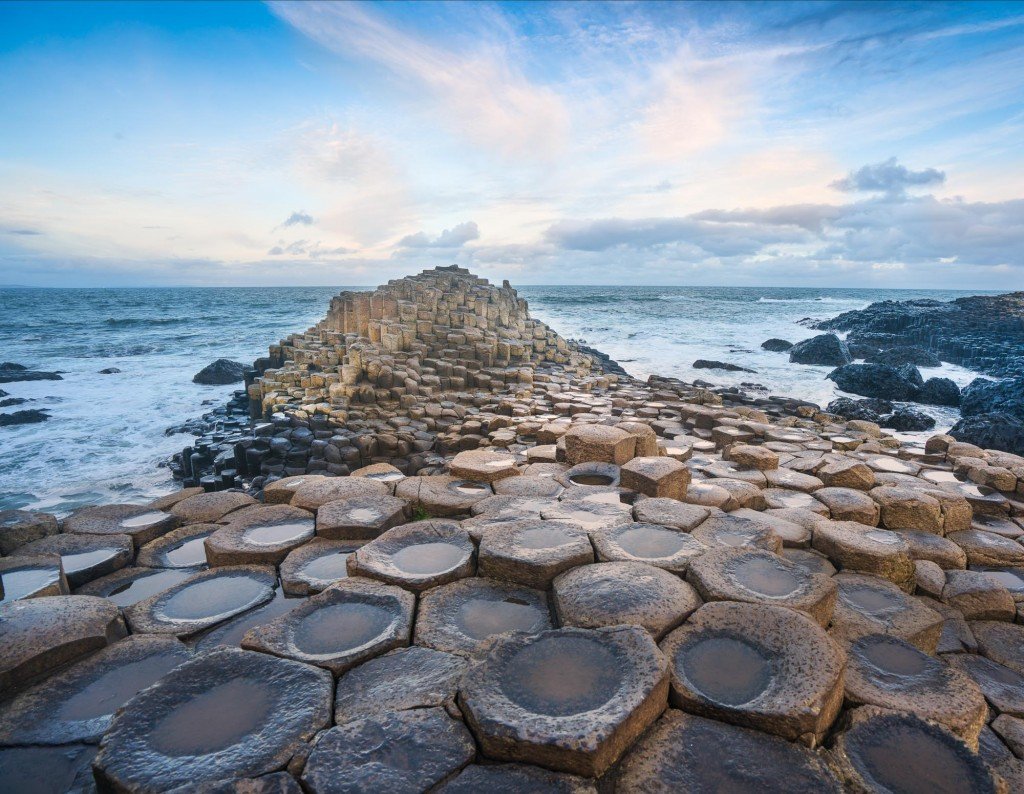
Dawn at the Giant’s Causeway on the Northern Coast of Ireland: Sony α7R II with Sony Vario-Tessar T* FE 16-35mm f/4 ZA OSS lens on a Sirui T-024X Traveler Light Carbon Fiber Tripod.
Why Not Canon or Nikon Full Frame Cameras?
Canon and Nikon owners will likely wonder why their cameras and lenses aren’t in this post. The quick answer is that their full format gear is heavier (mostly due to not being mirrorless like the Sony). So for the same image resolution (pMP) you are likely carrying approximately 1 to 2 pounds more weight for a Canon or Nikon camera/lens combination vs. the Sony camera/lens combination.
From the chart above you can see that mirrorless Sony a7R III (blue) is lighter (has more resolution per ounce of camera+lens weight) than Canon or Nikon full frame cameras. For the comparison I used three basic lens types common for backcountry use (below)—picking the most appropriate/similar camera and lens combination for each manufacturer. For all types of lenses listed, the Sony system is significantly lighter than Canon or Nikon.
- Utility Zoom = moderate cost ~24-70mm zoom. e.g. Sony 28-70mm F3.5-5.6 FE OSS Lens
- High-end Landscape Zoom = 16-35 quality zoom, e.g. Sony FE 16-35mm f/2.8 GM Lens
- Prime Wide Angle = a light 24 to 28mm lens f/2 or better, e.g. Sony FE 28mm F2
And just to be clear, both Nikon and Canon make great full frame cameras and lenses. Many professionals for years have been getting stunning photos in extreme locations with these cameras (e.g. Jimmy Chin, a personal hero of mine). But in the end, Nikon and Canon cameras are heaver than their Sony counterparts for similar resolution and image quality. To some that may not matter all that much. Finally, the camera and lens are only part of what makes a great picture. So to beat a dead horse, the photographer, good technique and above all being in the right place at the right time matter far more.
Footnotes
1 pMP (perceptual megapixels): Sharp as I use it in this post is the “perceptual megapixels” of the final image. This is a combination of both lens and camera—not simply the native resolution of the camera sensor! Thus a 45 MP camera, with an OK-but-not-great lens might only achieve a final photo with an resolution of 20 MP. That is, the pMP of the camera/lens combo is 20 pMP. Read more here on “What is sharp?”
Disclaimer
This post contains affilate links. If you make a purchase after clicking on the these links, a portion of the sale helps support this site at no additional cost to you. I do not receive compensation from the companies whose products are listed. For product reviews: unless otherwise noted, products are purchased with my own funds. I am never under an obligation to write a review about any product. Finally, this post expresses my own independent opinion.
© Jaeger Shaw, Sustain Succeed LLC, and AdventureAlan.com, 2000-2023 | All Rights Reserved
Unauthorized use and/or duplication of this material without express and written permission from this site’s owner is strictly prohibited. Brief excerpts and links may be used freely without express and written permission, provided that full and clear credit is given to AdventureAlan.com with appropriate and specific direction linking to the original content.
You make Adventure Alan & Co possible. When purchasing through links on our site, we may earn an affiliate commission at no additional cost to you.
Affiliate Disclosure | Privacy Policy | Terms and Conditions | Contact Us

